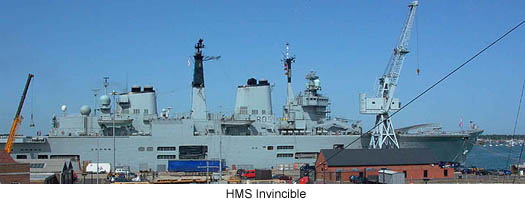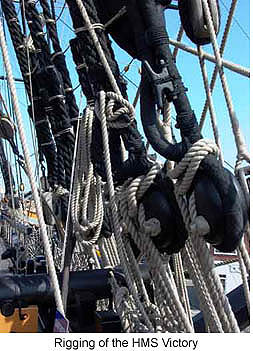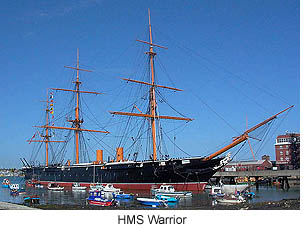A History of Firsts: Portsmouth Historic Dockyard
by Richard Crowhurst
Portsmouth is still home to the Royal Navy 810 years after the first dock was built on the orders of King Richard I. The year 2005 marks the 200th anniversary of Lord Nelson's famous, and fatal, victory at the Battle of Trafalgar on 21 October 1805. From its defensive location on the Solent Portsmouth will be the focal point for the celebrations, and will play host to the International Festival of the Sea from 30 June to 3 July, making this the ideal year to visit this historic site.
 Whether your interest is in naval or military history, architecture, industrial and social history, or if you just want a way to keep the kids occupied, Portsmouth Historic Dockyard is an ideal destination. It contains many separate attractions and allows you to explore three examples of the most cutting-edge and proficient warships of their period.
Whether your interest is in naval or military history, architecture, industrial and social history, or if you just want a way to keep the kids occupied, Portsmouth Historic Dockyard is an ideal destination. It contains many separate attractions and allows you to explore three examples of the most cutting-edge and proficient warships of their period.
A Brief History
In 1212 King John ordered a wall around the dockyard, and the site's importance to the Navy was confirmed. In 1495 King Henry VII built the world's first dry dock (the location, but not the original dock, is now home to HMS Victory). The culverts and tunnels that still channel water beneath the dockyard have their origins from this time. Henry VIII granted the official status of Naval Dockyard in 1540, by which time his famous flagship the Mary Rose had already been constructed by the yard. Portsmouth Dockyard has seen more 'firsts' and records than any other shipyard in its long history. Some of these include:
- 1495 -- World's first dry dock constructed by Henry VII.
- 1509 -- Laid down the Mary Rose, the first ship to have gun ports on her side.
- 1802 -- World's first cisson, or floating dam, installed at the entrance to the Great Ship Basin.
- 1850 -- The largest industrial site in the world.
- 1876 -- HMS Inflexible launched. At the time the world's largest battleship, and the first to be fitted throughout with electric lighting. Also the first to be launched by electricity.
- 1906 -- HMS Dreadnought constructed in a year. She was the first turbine driven warship.
- 1913 -- HMS Queen Elizabeth built. The first oil-fired battleship.
As the First World War approached, Portsmouth Royal Dockyard was producing almost a warship a year. The last of these before the war was the Royal Sovereign. Unsurprisingly, the city of Portsmouth and the dockyard were major bombing targets during the Second World War. Over 65,000 homes in the city were hit and the dockyard suffered major losses. For the first time in the dockyard's history, large 'capital ships' could not based at Portsmouth as it was simply too dangerous. However, the dockyard serviced and repaired thousands of ships and smaller vessels in dry dock and afloat during the war and played a major role in Operation Overlord -- the D-Day landings.
The last warship built (in only 364 days) at the dockyard was HMS Andromeda in 1967. Already an era was passing: in 1960 HMS Vanguard, the last of the Royal Navy's battleships, ran aground in old Portsmouth while being towed to the scrap yard. Today Her Majesty's Naval Base and HMS Nelson (Naval Barracks) is still the major employer in the area and the base for over 35 of Her Majesty's ships, including three Aircraft carriers.
Much of the historic heart of the old dockyard is now open to the public. Admission to the historic dockyard is free, including the restaurants and shops. Combined or individual tickets for the various attractions are available at the visitor centre or in advance. Visits can be split over a couple of days, giving you plenty of time to see everything and soak up the atmosphere. Remnants of Naval activity can also be found at nearby Gunwharf Quays and across Portsmouth harbour in Gosport.
The Mary Rose
The Mary Rose was the flagship of Henry VIII's navy, and the first ship to be used as such in a political, as well as a military, sense. She was commission by Henry's father, Henry VII, and named after his favourite sister. Launched in 1511, this ship employed a revolutionary carvel construction, whereby the planks were smoothly set edge-against-edge, allowing watertight gun ports on either side. This represented a major advance from the overlapping clinker-built ships that had preceded her.
A common myth is that the Mary Rose sank on her maiden voyage. In fact she had a distinguished career. It was on 19 July 1545, observed by Henry VIII, that she sailed out into a calm Solent to join the rest of the British fleet in repelling 225 French ships. Exactly what happened to her that day remains a mystery, but she listed sideways before sinking, taking an estimated 700 crew to a watery grave.
After more than 400 years she was rediscovered and carefully excavated, then carefully raised on 11 October 1982, an event that was televised to millions of viewers around the world. Since then, she and her artefacts have been carefully preserved, catalogued and displayed.
A ticket to see the Mary Rose covers both the remains of the ship herself and a fascinating exhibition. For twenty years the ship has been repeatedly sprayed with a special wax coating in the covered dry dock where she is kept. This treatment ensures that the timbers do not perish as the ship slowly dries out. The hall is being refurbished and this work should be completed by Easter 2005. Once finished it will offer the best view of the ship for ten years (in the past the wax has had a tendency to obscure the viewing windows around the ship).
HMS Victory
 Possibly the most famous warship from the age of sail, HMS Victory was built in the Royal Dockyards at Chatham in Kent between 1759 and 1765. She was commissioned in 1778 and remained in active service until 1812. She served as Nelson's flagship for two years, and a small plaque marks the spot on deck where he fell at Trafalgar in 1805. The First Sea Lord Admiral Sir Thomas Hardy (who was Victory's captain at Trafalgar) gave Victory a reprieve from the scrap yard at his wife's insistence. In 1889 she was designated the Flagship of the Commander-in-Chief at Portsmouth and she remains a commissioned ship, preserved by the Ministry of Defence. She was moved to her current location at Portsmouth and opened to the public in 1928 following extensive restoration. Although damaged by a bomb in 1941, she survived and is displayed as she was at the time of the Battle of Trafalgar.
Possibly the most famous warship from the age of sail, HMS Victory was built in the Royal Dockyards at Chatham in Kent between 1759 and 1765. She was commissioned in 1778 and remained in active service until 1812. She served as Nelson's flagship for two years, and a small plaque marks the spot on deck where he fell at Trafalgar in 1805. The First Sea Lord Admiral Sir Thomas Hardy (who was Victory's captain at Trafalgar) gave Victory a reprieve from the scrap yard at his wife's insistence. In 1889 she was designated the Flagship of the Commander-in-Chief at Portsmouth and she remains a commissioned ship, preserved by the Ministry of Defence. She was moved to her current location at Portsmouth and opened to the public in 1928 following extensive restoration. Although damaged by a bomb in 1941, she survived and is displayed as she was at the time of the Battle of Trafalgar.
HMS Victory is very popular so, if planning a visit, make a note of her opening times and arrive early. Also be prepared to have your bags searched for security purposes when boarding, and (as with other historic ships), be aware that there are low decks and steep ladders throughout. Your ticket for the Victory includes admission to the Trafalgar galleries of The Royal Navy Museum.
HMS Warrior
 Warrior (1860) and her sister ship HMS Black Prince (1861) were built in response to the French La Gloire, whose 'ironclad' wooden hull brought the war preparations of Napoleon III to the attention of the British. After much agonising the British Navy decided to build a ship with an all-iron hull, rather than simply covering wood with iron as the French had done. Warrior was constructed in a private yard in London and was launched in a mere 18 months. Once she was accepted into the Navy, all other warships became obsolete. Warrior could out-run and out-gun them all. By 1875 Britain had 22 armour-plated iron battleships in service. Warriorwas laid up in Portsmouth in 1883, never having needed to fire a shot in anger. Warrior (1860) and her sister ship HMS Black Prince (1861) were built in response to the French La Gloire, whose 'ironclad' wooden hull brought the war preparations of Napoleon III to the attention of the British. After much agonising the British Navy decided to build a ship with an all-iron hull, rather than simply covering wood with iron as the French had done. Warrior was constructed in a private yard in London and was launched in a mere 18 months. Once she was accepted into the Navy, all other warships became obsolete. Warrior could out-run and out-gun them all. By 1875 Britain had 22 armour-plated iron battleships in service. Warriorwas laid up in Portsmouth in 1883, never having needed to fire a shot in anger.
After an ignoble period of nearly a hundred years, HMS Warriorwas restored. She has been moored at Portsmouth since 1987 and is the first ship to greet you on your left as you enter the Dockyard by the famous Victory Gate.
Other Attractions in the Historic Dockyard
The Royal Navy Museum is spread over three brick storehouses that line the main road into the dockyard from the gate. It contains galleries about the Navy in the 20th century and the age of sail, as well as Nelson and the Battle of Trafalgar (about which there is an excellent audiovisual exhibition). Between 18 March and 30 October 2005 it will be possible to see The Trafalgar Sail, the only remaining sail from the battle. The exhibition of the sail forms part of the bicentenary of the battle of itself. The museum is also hosting Special Trafalgar Exhibitions beginning in 5 May 2005.
The Dockyard Apprentice provides a glimpse of working life in the dockyard in the early 20th century. Many of the exhibits are hands-on and ideal for children (large and small alike!), who can try their hands at a variety of ship-building skills.
Action Stations is one of the newest attractions in the dockyard. It is housed behind the brick facade of Boathouse No. 6, which also conceals a remarkable steel scaffold construction. This interactive exhibition is home to a professionally produced film show, interactive exhibits and numerous simulators, all of which show how the Royal Navy operates in the 21st century. A new gallery called Inter-Action is also planned for later in 2005.
Boat Tours leave regularly from the jetty alongside HMS Warrior and take you on an interesting guided tour of the Portsmouth harbour and the naval dockyards. This is the best way to view the active navy ships lying in port for servicing or supply, as well as to see the bustling commercial activity in the port. The tours also stop off at Gunwharf Quays.
Between 1739 and 1800, two porters, William Woodrow and Thomas Butler were charged with dockyard security. They prevent excessive theft of materials, guarded the boundaries of the dockyard and marked working hours. They also dispensed beer to keep the workers happy! The quiet gardens alongside the wall by the Porter's lodge are a quiet place to reflect after the bustling exhibits.
Gunwharf Quays
This site, a few minutes walk from the Historic Dockyard, is now a thriving retail, leisure and development containing shops, restaurants, bars and cafes. There is also a cinema, bowling complex, casino, fitness club and hotel. The latter, while basic, is ideal for those on a budget who want access to great nightlife and leisure activities while being as close as possible to the Historic Dockyard.
The site of Gunwharf Quays was one of the original naval locations in Portsmouth. In the 17th century the first main ordnance yard for the Navy was established here. Ships would collect their gunpowder, canon balls and other weapons before going to sea. Over the years the site was home to HMS Vernon (the Naval Torpedo School) and the navy's Deep-diving unit. Today it is a conservation area, and many important buildings remain to be viewed and enjoyed.
Other Local Attractions
There is plenty to see and do in the Portsmouth area. There are regular ferry links to Gosport (across the harbour) and the Isle of Wight (across the Solent). There is also a continental ferry port with sailings to the Channel Islands, France and Spain. Gosport is home to the Submarine Museum and worth a day out in its own right, as is Portsmouth Old Town. Famous former residents include Charles Dickens and Isambard Kingdom Brunel who were both born in the city.
Getting There
By Road: There are excellent motorway links and the docks and Gunwharf Quays are clearly signposted. The nearest bus terminus is about five minutes from Gunwharf Quays.
By Train: Portsmouth Harbour Station lies between Gunwharf Quays and the historic dockyard and there are frequent services to major cities across the UK.
More Information:
We regret that we no longer have the resources to maintain up-to-date links and/or hours and pricing details for the various sites and attractions listed on this website. For more information about the location(s) listed above, please use your favorite search engine or visit Wikipedia.
Richard Crowhurst is a freelance writer and author based in Lincolshire,
England. He writes on many subjects, including history and heritage topics.
More details can be found on his website, http://www.freelance-writer-and-author.co.uk.
Article and photos © 2005 Richard Crowhurst
| 